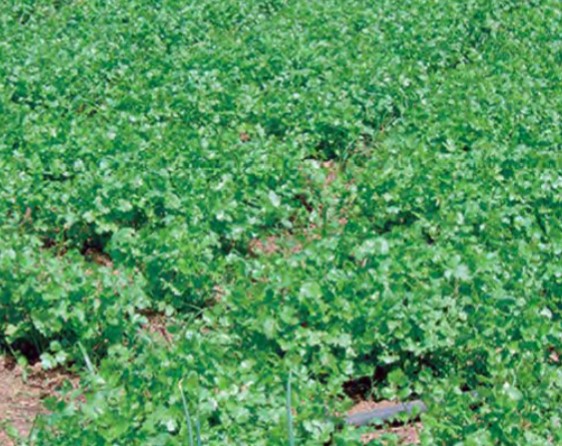Fertilization evaluation in the coriander crop
Abstract
In recent years, in the urban area and its periphery, representatives of public and private organizations have developed activities of an agricultural nature, seeking as an objective the sanitation and recovery of underused spaces, the production of fresh, healthy, quality inputs or food, economic, and also, the formation of a fruitful citizen capable of forging, financially helping and contributing to the production of food for himself and the community, thus contributing to food security; by seeking to correspond with what is established in the Constitution of the Bolivarian Republic of Venezuela (1999), regarding the establishment of sustainable agriculture as a strategic basis for the integral development of the country.
The development of programs carried out by State agencies in urban areas has led in some cases to the planting of vegetables, especially the so-called medicinal, aromatic and condiment herbs, among which is the cultivation of coriander, Coriandrum sativum L. , considered as the leafy vegetable consumed as fresh foliage in the meals prepared by the Venezuelan (Sulbaran and Toro, 2008).
Coriander is a vegetable of high global consumption in foliage and seed, its origin is established since ancient times as a condiment and medicinal plant (Cruz, 2004), it is a herbaceous plant of the Umbelliferae family, annual, 40 to 60 centimeters high , with erect, smooth and cylindrical stems, branched at the top (Sulbaran and Toro,
2008). All the leaves are pinnate while the basal or lower leaves are tripinnate.
The flowers are small, white or slightly pink, arranged in terminal umbels. The fruits are diachenes, globose, with 10 longitudinal primary ribs and 8 secondary ribs, made up of tightly united mericarps, colored
Brown yellow. They have a mild, pleasant smell and a strong, spicy taste. It contains two seeds, one for each achene. The roots are thin and highly branched.
For optimal foliage production in coriander, between 200 to 300 plants per square meter are needed (Arcos, 2002 and Mejías et al., 2014). The sowing is done directly, the seed is distributed by broadcasting in a uniform way, covering it later with a thin layer of soil of 0.5 cm. The vegetative period of different varieties lasts around 45 to 50 days and reaches yields of eight tons of fresh foliage, manual weed control is essential.
Fertilizers provide the soil with the necessary nutrients to promote optimal plant development, therefore fertilization is one of the aspects that the producer must manage to obtain good yields, it has been determined that fertilization has an inherent effect both in the yield as in the production of essential oils and in the quality of the seed (Usman et al, 2003). Nitrogen extraction in the crop ranges between 46 and 81 kg / ha and that of potassium between 90 and 141 kg / ha; the potassium concentration in the tissue is high, 5.5% on average. The fresh foliage yield varies between 1.2 and 1.8 kg / m2 and the seed yield varies between 1,433 and 2,266 kg / ha of pure seed (Mejía and Estrada, 2008).
Por lo antes mencionado, esta investigación tuvo como objetivo evaluar dos tipos de abonos o fertilizantes en el crecimiento y desarrollo del cilantro. El primero fue humus de lombriz considerado como orgánico y el segundo un abono comercial Horticultor (12-12-17/2 MgO). Se utilizó la variedad comercial de cilantro Long Standing, una variedad sembrada comúnmente por los agricultores ya que posee brotes vigorosos, de color verde claro e intenso aroma, también por adaptarse a ambientes frescos y cálidos (20 - 27°C) ubicados de 800 a 1500 metros sobre el nivel del mar. Además, presenta una alta resistencia al transporte, después de arrancarse (Foto 1).
References
Constitución de La República Bolivariana de Venezuela. 1999.
Cruz, Y. (2004). Evaluación del comportamiento agronómico del cultivar de cilantro Unapal precoso, Coriandrum sativum L. y de lechuga Simpson Lactuca sativa L. bajo tres formas de abonamiento en un Andosol en el departamento del Valle del Cauca. Tesis de grado. 44 p.
Mejía, M., G. Marín y J. Menjivar J. (2014). Respuesta fisiológica de cilantro (Coriandrum sativum L.) a la disponibilidad de agua en el suelo. UNAL.EDU.CO. Agronómica. 63 (2), 246-252 pp.
Mejía, S., E. Estrada y O. Figueroa. (2008). Respuesta fisiológica del cilantro a diferentes niveles de potasio y nitrógeno. Acta agronómica. Universidad Nacional de Colombia sede Palmira. 4 p.
Sulbarán Karina y M. Toro. (2008). Germinación y crecimiento del cilantro (Coriandrum sativa) cultivado en bambú (Bambusa Arundinaria). Revista Científica Juvenil. Mérida-Venezuela. ISSN 1316-9505 Vol. VII: 45-48 pp.
Usman, D.C., R. Usman, C.R. Bonilla y M. Sánchez M. (2003). Efecto de la fertilización orgánica sobre la producción de follaje y rendimiento de semilla de cilantro Coriandrum sativum L. Variedad Unapal Precoso. Acta agronómica (Palmira) 52 (1/4): 59-63 pp.


